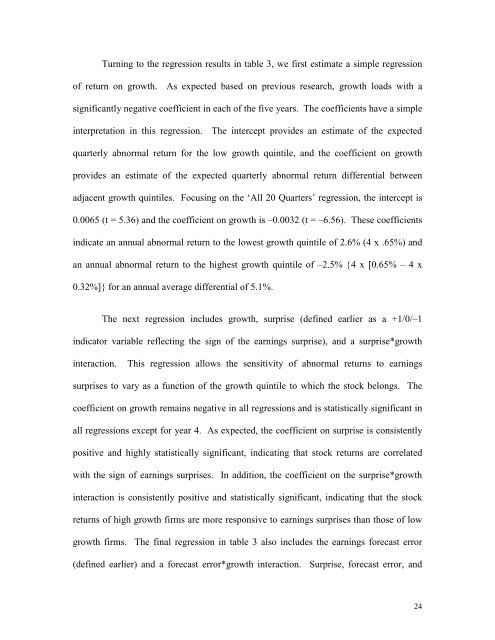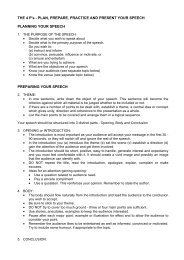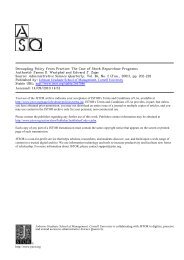Earnings Surprises, Growth Expectations, and Stock Returns:
Earnings Surprises, Growth Expectations, and Stock Returns:
Earnings Surprises, Growth Expectations, and Stock Returns:
Create successful ePaper yourself
Turn your PDF publications into a flip-book with our unique Google optimized e-Paper software.
Turning to the regression results in table 3, we first estimate a simple regression<br />
of return on growth. As expected based on previous research, growth loads with a<br />
significantly negative coefficient in each of the five years. The coefficients have a simple<br />
interpretation in this regression. The intercept provides an estimate of the expected<br />
quarterly abnormal return for the low growth quintile, <strong>and</strong> the coefficient on growth<br />
provides an estimate of the expected quarterly abnormal return differential between<br />
adjacent growth quintiles. Focusing on the ‘All 20 Quarters’ regression, the intercept is<br />
0.0065 (t = 5.36) <strong>and</strong> the coefficient on growth is –0.0032 (t = –6.56). These coefficients<br />
indicate an annual abnormal return to the lowest growth quintile of 2.6% (4 x .65%) <strong>and</strong><br />
an annual abnormal return to the highest growth quintile of –2.5% {4 x [0.65% – 4 x<br />
0.32%]} for an annual average differential of 5.1%.<br />
The next regression includes growth, surprise (defined earlier as a +1/0/–1<br />
indicator variable reflecting the sign of the earnings surprise), <strong>and</strong> a surprise*growth<br />
interaction. This regression allows the sensitivity of abnormal returns to earnings<br />
surprises to vary as a function of the growth quintile to which the stock belongs. The<br />
coefficient on growth remains negative in all regressions <strong>and</strong> is statistically significant in<br />
all regressions except for year 4. As expected, the coefficient on surprise is consistently<br />
positive <strong>and</strong> highly statistically significant, indicating that stock returns are correlated<br />
with the sign of earnings surprises. In addition, the coefficient on the surprise*growth<br />
interaction is consistently positive <strong>and</strong> statistically significant, indicating that the stock<br />
returns of high growth firms are more responsive to earnings surprises than those of low<br />
growth firms. The final regression in table 3 also includes the earnings forecast error<br />
(defined earlier) <strong>and</strong> a forecast error*growth interaction. Surprise, forecast error, <strong>and</strong><br />
24







